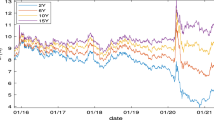Abstract
The default probability is a central parameter of credit risk models and can be estimated by the relative default frequency in a portfolio. The distribution of this estimator is derived in the framework of a single-factor model. For a sample portfolio consisting of 15 rating categories with different default probabilities individual and simultaneous probability intervals are given.
Access this chapter
Tax calculation will be finalised at checkout
Purchases are for personal use only
Preview
Unable to display preview. Download preview PDF.
Similar content being viewed by others
References
Basel Committee on Banking Supervision (2001a): The New Basel Capital Accord, Consultative Document. BIS, Basel.
Basel Committee on Banking Supervision (2001b): The Internal Ratings-Based Approach: Supporting Document to the New Basel Capital Accord, Consultative Document. BIS, Basel.
Basel Committee on Banking Supervision (2001c): Potential Modifications to the Committee’s Proposals. BIS, Basel.
BUHLER, W., ENGLE, C., KORN, O., and STAHL, G. (2002): Backtesting von Kreditrisikomodellen. In: A. Oehler (Ed.): Kreditrisikomanagement — Kernbereiche, Aufsicht und Entwicklungstendenzen. 2nd edition, Schaffer-Poeschel, Stuttgart, 181–217.
BÜSCHER, S. (2002): Erste Umsetzungsverfahren einer Sparkasse mit dem einheitlichen Rating-Verfahren. Betriebswirtschajtliche Blätter, 05, 241–249.
HÖSE, S. and HUSCHENS, S. (2003): Sind interne Ratingsysteme im Rahmen von Basel II evaluierbar? — Zur Schätzung von Ausfallwahrscheinlichkeiten durch Ausfallquoten. Zeitschrijt für Betriebswirtschajt, accepted for publication.
HUSCHENS, S., LOCAREK-JUNGE, H. (2000): Konzeptionelle und statistische Grundlagen der portfolioorientierten Kreditrisikomessung. In: A. Oehler (Hrsg.): Kreditrisikomanagement — Portfoliomodelle und Derivate. Schäffer-Poeschel, Stuttgart, 27–49.
HUSCHENS, S. and VOGL, K. (2002): Kreditrisikomodellierung im IRB-Ansatz von Basel II. In: A. Oehler (Hrsg.): Kreditrisikomanagement — Kernbereiche, Aufsicht und Entwicklungstendenzen. 2nd edition, Schäffer-Poeschel, Stuttgart, 279–295.
Author information
Authors and Affiliations
Editor information
Editors and Affiliations
Rights and permissions
Copyright information
© 2003 Springer-Verlag Berlin Heidelberg
About this paper
Cite this paper
Hose, S., Huschens, S. (2003). Estimation of Default Probabilities in a Single-Factor Model. In: Schader, M., Gaul, W., Vichi, M. (eds) Between Data Science and Applied Data Analysis. Studies in Classification, Data Analysis, and Knowledge Organization. Springer, Berlin, Heidelberg. https://doi.org/10.1007/978-3-642-18991-3_62
Download citation
DOI: https://doi.org/10.1007/978-3-642-18991-3_62
Publisher Name: Springer, Berlin, Heidelberg
Print ISBN: 978-3-540-40354-8
Online ISBN: 978-3-642-18991-3
eBook Packages: Springer Book Archive




